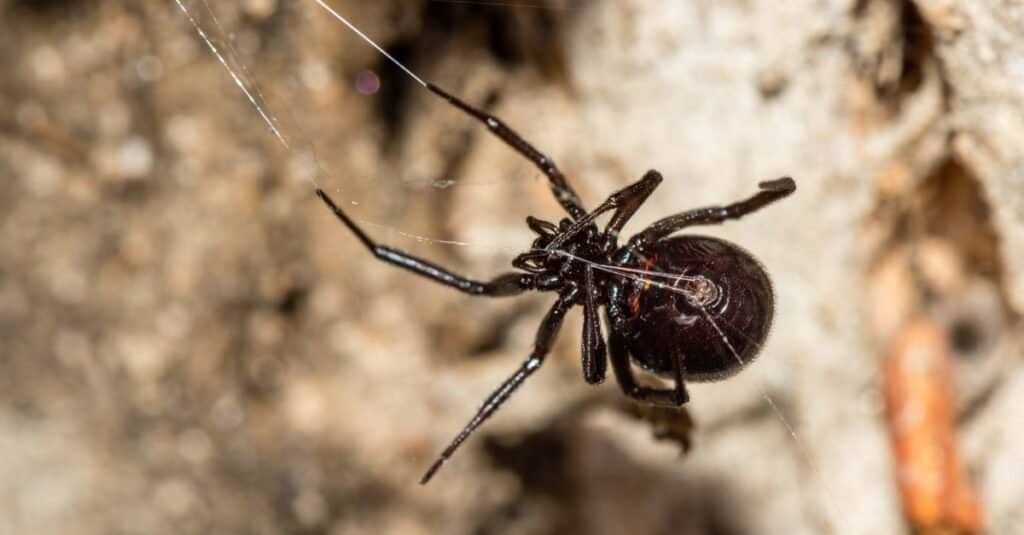False Widow Spider
Steatoda grossa
False spiders actually prey on black widow spiders and other hazardous spiders
Advertisement
False Widow Spider Scientific Classification
- Kingdom
- Animalia
- Phylum
- Arthropoda
- Class
- Arachnida
- Order
- Araneae
- Family
- Theridiidae
- Genus
- Steatoda
- Scientific Name
- Steatoda grossa
Read our Complete Guide to Classification of Animals.
False Widow Spider Conservation Status
False Widow Spider Facts
- Prey
- Other spiders and various insects
- Group Behavior
- Solitary
- Fun Fact
- False spiders actually prey on black widow spiders and other hazardous spiders
- Litter Size
- Egg sacs can consist of up to 200 eggs
View all of the False Widow Spider images!
With a similar dark, globular body for identification, the false widow spider is often mistaken for the black widow.
While mistaken for look-alikes, they are two different spiders. Science traces the false widow’s origins to the Canary Islands and Madeira. It’s believed the creature stowed away on transatlantic trips. That’s why today, the false widow’s found all over North Africa, Europe, West Asia and in parts of South and North America.
5 False Widow Spider Facts
Here are some interesting stats about the false widow spider.
- Though often mistaken for the deadly black widow spider, the false widow is harmless.
- While the previous fact is backed by science, a new Science Daily report claims not only are the insect’s bites on the rise but the severity can require hospitalization. Still, there is no record showing the false spider can kill.
- For the layman, identifying spiders isn’t easy. Most actions attributed to the false widow are actually caused by completely different species.
- The growing frequency of bites is likely because of the species spreading and growing, especially in the U.K.
- A large portion of bites from this insect seems to take place as the victim sleeps in their home.
False Widow Spider: Species, Types, and Scientific Name
Let’s take a closer look at the false widow.
Species
The false widow spider is a member of a species in the genus Steatoda.
Types
The most common taxonomy in the group is the rabbit hutch, the cupboard, and the noble false widow and the false widow. But there happen to be six species in total.
- Steatoda nobilis
- Steatoda grossa
- Steatoda bipunctata
- Steatoda albomaculata
- Steatoda triangulosa
- Asagena phalerata
Look-alikes for the black widow, the false spider is all brown or black, a rotund family of creatures that grow to about the size of a fingernail.
Scientific Name
The scientific identification name for the false widow is Steatoda grossa.
Appearance: How To Identify the False Widow Spider
The false widow’s body is a glossy chocolate brown. It’s not unusual for the spider to be reddish-brown. The creature lacks the red hourglass marking and instead has unique cream markings. The false widow shares the black widow’s rounded, bulbous abdomen. The false widow is also noticeably smaller than the mature Western black widow.
The female spider has an average length between 0.27 and 0.59 inches. The males are typically in the vicinity of 0.16 to 0.27 inches in length. In general, the spiders weigh around 0.03 ounces.

©Danie Spreeth Photography/Shutterstock.com
Habitat: Where to Find the False Widow Spider
With origins in the Canary Islands and Madeira before becoming a common species in Ireland‘s urban homes, the false widow is now common all over the globe. Research looking for identification behavior said nearly all bite victims got attacked in their homes as they slept or got trapped in clothing. A number of bites seem to have occurred, oddly enough, while homeowners were working on DIY projects.
Though naturally preferring to be indoors, the false widow is also seen living in cacti, telephone poles, ivy, concrete fence posts, and roadside cuttings. Their invasions also include man-made structures of concrete, steel, and timber in urbanized regions. In California, the spread of the false widow began in urban habitats and moved to natural ecosystems.
The younger spiders live in holes and crevices, making it harder to kill them. They also lean heavily toward living on leaves and vegetation.
Diet: What Do False Widow Spiders Eat?
There are members of the scientific and insect community who argue the false widow spider is beneficial to the household. They patrol the home hunting prey likely to cause long-term damage. When left alone, spiders like these are harmless and they chow on household pests. That’s fruit flies, mosquitoes, house flies, and numerous other pests. And most of these pose a greater threat to human health than the false widow spider.
Prevention: How to Get Rid of the False Widow Spider
While there is an argument to the benefits of having false widow spiders, some people just don’t want the critters around. We can certainly understand why you don’t want these spiders on your business premises.
So, those non-fans of arachnids (and there are many) may want to manage the false widow invasion. Here are a few ways to take care of the situation.
- Put lavender, plant mint or both, near or underneath your windows. Spiders really don’t appreciate the odor. The taxonomy also implies spiders don’t like citrus. Rub peel from limes or lemons on the window sills and skirt boards, or apply lemon-scented polishes and cleansers to the same surfaces. Other scents rumored to keep false widow spiders out are eucalyptus, peppermint and tea tree oil.
- Vinegar is supposedly THE spider killer. The acidity burns the spider on contact. Do this with a concoction equal parts water and vinegar. Spray it directly on the spider and should you come across a sac, spray all sides of it liberally.
- Spiders rely on webs for shelter and food. Removing them is a strong defense to warding them off. Get the corners and areas beneath furnishings as spiders like to hide. Target egg sacs carefully. Once done, discard the debris in the vacuum canister.
- Insecticide treatments come in liquid and dusting options. Use dusts where they won’t get disturbed by humans or pets, like in the crawl spaces and basements. Liquid treatments are best for others, such as where the arachnids keep their webs. Insecticides should kill present spiders and increases the prevention of new ones.
- Oil-based solutions are good for targeting egg sacs. Pyrethrin’s a good option. It kills spiders and prevents others from getting into your attic, home or garage.
- By reducing food sources, you naturally reduce the likelihood of spiders. So, if you have flies, grasshoppers, earwigs, moths or other pests, putting out traps for them is a good idea. This is especially true if you have these creatures in your exterior perimeters.
False Widow Spider FAQs (Frequently Asked Questions)
How do I identify a false widow spider?
The false widow spiders are look-alikes for the deadlier black widow. They both have bulbous, round abdomens. Males are more elongated compared to females and have thinner bodies. The false widow is brownish with pale markings which is how you differentiate it from the black widow.
What is a false widow spider?
The false widow form s species of spider that resembles the black widow (hence, the false widow moniker). The resemblance causes some concern in communities where the difference isn’t identifiable to the layman. Unlike the black widow, false widows do not have a dangerous bite that can kill.
What do I do if I find a false widow spider?
If you come across a false widow, place a glass or container over it. Now slide a piece of cardboard or another flat surface under the container. Pick everything up carefully and release the spider outdoors, preferably away from the property.
How do I get rid of a false widow spider?
If you’re having an invasion of false widows, perform a thorough vacuuming of infested areas. You can remove the webs and spiders. Control is also feasible if you control the insect and its prey. You may need to apply insecticidal treatments for prevention.
Are false widow spiders dangerous?
They are not deadly in general. Some species have a venomous bite, but it’s not necessarily potent. The only symptoms are radiant pain around the infected area.
Where do false widow spiders live?
Originating from the Madeira and Canary Islands, their migration led to Europe, West Asia, North Africa, as well as parts of South and North America. The spider prefers indoor living, taking refuge in homes and other structures. They prefer conservatories and upper corners.
What happens if I get bitten by a false widow spider?
The bite is not known to kill. If bitten, symptoms are pain surrounding the bite. The pain lasts as little as one hour and up to 24. On average, symptoms are similar to a wasp sting and lasts about 12 hours.
Are false widows usually alone?
The false widow prefers solitude. They are nocturnal, rarely going out during the day. The spiders hide out in cracks near their webs.
Thank you for reading! Have some feedback for us? Contact the AZ Animals editorial team.
Sources
- Pen State Extension / Accessed October 5, 2021
- kidadl / Accessed October 5, 2021
- Lawn Starter / Accessed October 5, 2021
- Somerset Live / Accessed October 5, 2021
- Wikipedia / Accessed October 5, 2021
- Irish Examiner / Accessed October 5, 2021
- Orkin / Accessed October 5, 2021
- Natural History Museum / Accessed October 5, 2021
- Express / Accessed October 5, 2021


















